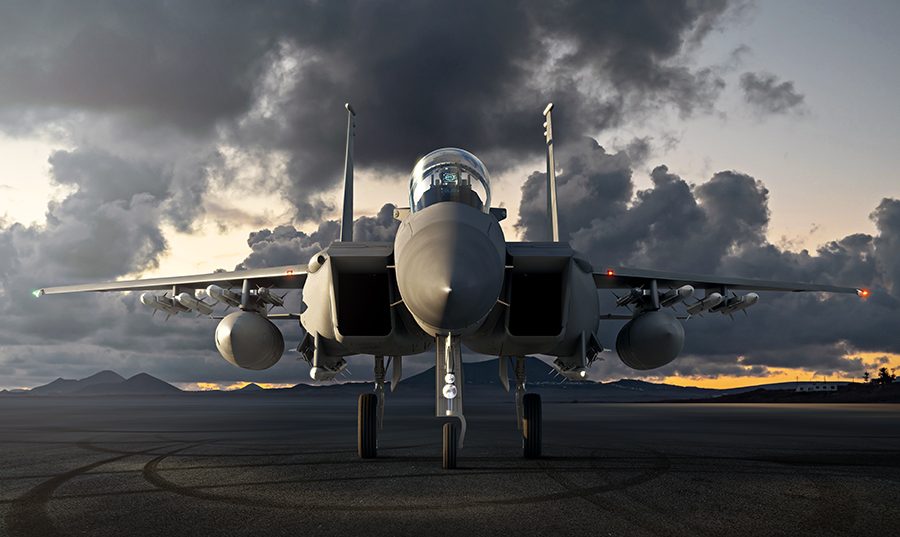The Air Force doesn’t have to buy all 144 Boeing F-15EX aircraft covered by last month’s major contract award and can terminate the program simply by not ordering any more of the jets, according to Air Force Materiel Command.
In response to a series of email queries from Air Force Magazine about whether USAF has any off ramps to buying 144 F-15EXs over the next 15 years—especially given that the service is also buying fifth-generation F-35s and will soon start buying the even more advanced Next-Generation Air Dominance airplane—AFMC noted that the nearly $23 billion contract awarded to Boeing is of the “indefinite delivery/indefinite quantity” type. It said USAF has not entered into an agreement to buy all the planes the contract could potentially cover. The $1.2 billion actually spent in the July 13 contract covers just the first eight test aircraft and development.
The contract is “structured to accommodate annual delivery orders for each aircraft lot and required product support elements,” an Air Force Life Cycle Management Center spokesman said. “Until the orders for each lot are awarded, the government has no financial liability for those aircraft” and supporting materiel.
“Thus, the most straightforward way for the Air Force to reduce the total procurement quantity is simply to stop placing new delivery orders,” the spokesman said.
If the Air Force wanted to quit the contract in the middle of a delivery cycle, it would be at the government’s convenience, and Boeing could recover “allowable costs and reasonable profit on work performed under the contract.”
The deal provides up to $22.89 billion for F-15EX work, but the dollar figure was described by a USAF spokeswoman as an “upper limit.” The contract actually allows up to 200 airplanes to be bought, with deliveries through 2035. The jets are supposed to replace aging F-15C/Ds, but the Air Force recently revealed that it hasn’t decided whether it will also tap the F-15EX to replace its fleet of F-15Es, which age out in about 2030.
In documents recently released by USAF justifying the sole-source contract to Boeing, the Air Force said the F-15C/D fleet is rapidly aging beyond its planned service life, and retiring the jet without a replacement in hand would leave the service short of the capacity it needs to fulfill the National Defense Strategy.
The Pentagon has been criticized for not simply buying more F-35s instead of buying “new-old” F-15s, as the Air Force has described such a move for the last 20 years.
Outgoing head of Air Combat Command Gen. James M. “Mike” Holmes, in an Aug. 14 AFA live-streaming event, said the F-15EX program is the result of the Office of the Secretary of Defense trying to fix a near-term shortage of USAF fighter capacity.
The Cost Assessment and Program Evaluation shop (CAPE) examined the mix of fourth- and fifth- generation fighters for all the services, and decided USAF needed at least 48 fifth-gen F-35s per year to “compete” with China, Holmes said. But at that rate, the USAF fighter inventory’s average age still continued to increase. The Air Force calculated that it needed 72 fighters a year to really drive down the average age of the fleet, which would in turn reduce the cost of sustaining it.
“They came back and said, ‘Okay, we understand that math, but we still have our fourth-/fifth-gen mix equation, so if you’re going to buy additional airplanes, we want to buy fourth-gen,” Holmes said. The advantages for USAF, he added, are that new F-15EXs can make use of facilities, training, and ground support gear very similar to that of the F-15C/D, and USAF can field it up to three years faster than if it was buying all F-35s, Holmes said
“So, … Congress has given us some of both,” Holmes said, buying some F-35s “and then buying some F-15EXs.”
In addition to the F-35 and NGAD, the Air Force is also planning to acquire Low-Cost Attritable Aircraft in the coming decade, along with service life extensions and capability upgrades for the A-10 and F-16. The NGAD will likely be the product of USAF acquisition chief Will Roper’s “Digital Century Series” idea, which will field a number of advanced aircraft types in quantities of less than 100 each. It isn’t clear when the first of those might become available, but USAF has said it needs to field new platforms by around 2030 to assure control of the air. Holmes has said USAF will likely need two types of air dominance airplanes in the 2030s: One with long range for the Indo-Pacific theater, and one with shorter range more suited to the distances in Europe and the Middle East.
The Air Force has allowed that with flatter budgets anticipated in the coming years, the full range of air dominance platforms now planned may not all be affordable.
